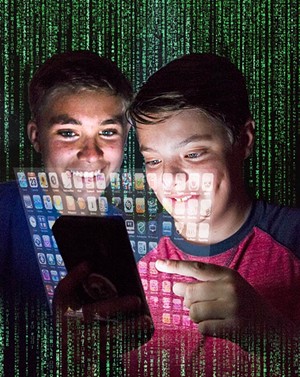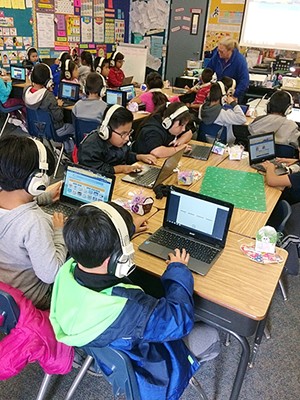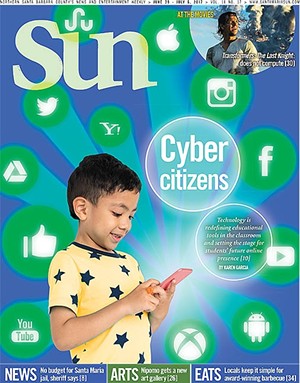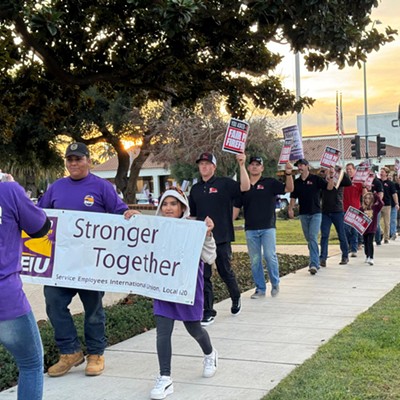Elementary school projects used to consist of macaroni pasta shells, toothpick bridges, and soft pipe cleaners. Today, Baywood Elementary School students in Los Osos use a 3-D printer to make materials for their projects.
Third-grade teacher David Curran said the possibilities are endless when it comes to technology and the tools that can be used to educate. Curran is currently the only teacher in the San Luis Coastal Unified School District with a 3-D printer in his classroom.
“I was inspired to get a 3-D printer because I saw that my students are deeply skilled in spatial reasoning and love to problem solve,” he said. “We have been working a lot with programming and writing code, a challenging concept that students are thriving in.”
He wrote a grant to get the technology into his classroom so that his students could use it as part of their academic curriculum. The class uses an online program called Tinkercad, a design and printing app, to bring his students’ creations to life.
The latest project for his third graders was printing 3-D model cars and analyzing why certain cars traveled faster after taking them for a test run on an incline track.
“We would make observations on why certain cars traveled faster, and then have in-depth studies on forces and motion,” he said.
Your average classroom still has the same old desks, and white boards take the place of chalkboards, but technology—like Chromebooks and iPads (and, apparently, 3-D printers)—is rapidly taking the place of textbooks and note taking. The struggle, Curran said, is how to incorporate all those new tools into everyday teaching curriculum and how to mindfully balance the use of technology in the classroom. Local educators are also grappling with how to get students to behave responsibly online.
“How can we bring in technology that not only supplements older technology but how can we use it [in a way] that’s redefining the learning for students,” Curran said.
Redefining teaching
Walk into a classroom and during certain parts of the day, students will be working from behind the screens of Chromebooks while teachers pace between rows of students, bringing the screens to life with interactive PowerPoint presentations and programs their students can follow along with.
For Aaron Shrogin, principal at Bonita School in Santa Maria, this is a far cry from the computer lab of the past. Instead of a dedicated room for desktop computers used by a class at a time, classes at Bonita use mobile Chromebook labs in their classrooms and elsewhere.
“That whole concept is kind of obsolete now,” Shrogin said. “Now we’ve moved to wireless connections throughout the school, we’ve upgraded our broadband. We now have excellent broadband in the quad, on the playgrounds, and in the cafeteria.”
Currently, Bonita School uses Google Apps and other supplementary programs to teach and connect with students.

ILLUSTRATION BY ALEX ZUNIGA
An extension of the app is called Google Classroom, where class discussions and documents can be shared in real time. Teachers can comment on their students’ work, and students can comment on each other’s work.
Such programs set the stage for teaching students how to post and have discussions online.
“The more they work online, the more maturity they have with those devices,” Shrogin said, “and the better prepared they’re going to be for all the challenges that face them ahead.”
Shrogin said that more and more important schoolwork—like state testing, district testing, and school assessments—are done online or with computers now.
While addressing online resources and their benefits is taking place at all grade levels, social media is something currently saved for high school students.
“You know, social media is problematic, and it’s especially problematic with young kids. They’re really not even supposed to be on Facebook and such at the age that they are at elementary school,” he said. “For the most part, we try to let them work on that stuff on their own at home, and we discourage that from going on at school because most of the time that’s a distraction and that’s not where we want it to go.”
Kay-Kay Clapp doesn’t remember having conversations about online presence when she was in school, but she does think having such discussions early is a good idea.
Clapp is the director of communication for iFixit in San Luis Obispo, a company that specializes in creating free repair guides for all kinds of devices. She worked as a hiring manager for six years at three different companies in San Luis Obispo County and has definitely researched a candidate’s online presence.
“I always try to look at people’s social profiles just to get a sense of who they are,” she said.
When she worked for Shopatron, now known as Kibo—a software firm that aids companies in improving their business model and customer experience—she said she hired a lot of Cal Poly interns.
“You know you’re not going to hold anyone to their social profiles, people drink in college and all that good stuff,” Clapp said. “I always vetted them to see: Are they partying non-stop, what are they posting on their Facebook wall, and is it appropriate?”
Typing a name into the Google search bar opens the door to a closet full of old posts, stories of local sports game losses, or photos shared from other accounts with the same name tagged on it.
“You never know where you’re going to go [in the future], especially in high school, so as far as advice goes, just be clean and professional,” she said. “Just think, would you want your mom to see that?”
Opening up the conversation of how easy it is to trace a person’s online history is a good place to start. The second issue high schools are tackling is how students conduct themselves on social media and the consequences that could follow.
Pandora’s online box
Glenn Holzer walks the grounds of high school campuses as a school resource officer. He’s appointed to the Lucia Mar Unified School District from the SLO County Sheriff’s Office to ensure campus safety and as a deterrent.
Resource officers are on campus so often, Holzer said, that students are comfortable talking to them and approaching them if there’s an issue.
“We have a bit more time to build that bond with these students rather than a deputy that’s going from call to call,” Holzer said.
He said the attitude of these kids has changed over the last several years, and he attributes it to the access they have at their fingertips.
“This generation is growing up with technology, but it doesn’t mean they have the coping skills for it,” he said. “It doesn’t mean they have the perspective to make good decisions.”
That technology is an unspoken language: social media, texting, and photos that often can’t be deleted. A simple screenshot of a private conversation or photo can be saved and shared. Holzer said that in an instant, a private, personal exchange can be shared with one or two students or the entire 10th grade class. The results can be damaging and painful for both parties—whether it’s between students, faculty, or the entire school. In late May, a student at Morro Bay high school was arrested on suspicion of making threats against the school on social media. And in early April, Santa Barbara County Sheriff’s deputies arrested an Ernest Righetti High School student for posting photos of airsoft guns with a caption about bringing them to Orcutt Academy High School.
“That attitude, the right to just spread anything, and thinking it’s OK, it’s not because you’re hurting people,” Holzer said. “And we never had a medium like that.”
At that age, a student’s society encompasses school, friends, and family, and Holzer said their entire world can all be accessed through a cellphone or a computer.
“Parents are handing these younger children these phones that are basically full-blown computers, and some parents don’t know much about them,” he said.
School administrators have reached out to the SLO Sheriff’s Office to figure out how they can educate their students about social media.
As part of the sheriff’s crime prevention department, Brandy Swain visits classrooms to educate students on the legal consequences of online misuse, and the potential dangers of the Internet and the social media platforms.

Her main focus is to make students aware of the consequences of having an open social media profile—one that’s viewable by anyone and everyone. She said if a student has an account with hundreds of followers, then each follower (and some of the people who follow that person) has access to their posts, comments, and photos.
“I’m just reinforcing the message that social media isn’t a private way of communicating with friends. It’s a public forum,” Swain said.
Her suggestion is to keep accounts private and only allow friends and family to view the profile and its contents.
Even though she visits classrooms and has these discussions with students, Swain said parents need to play an active role in that dialogue. And the conversation needs to start the minute a parent hands over a smartphone or gives their child access to the internet.
“It’s a dialogue that you can’t have just once as a parent. It’s going to be like talking to them about drugs and alcohol; it’s something that you’re going to have to be constantly checking in with,” she said.
Once the screen of the device lights up, parents should understand what their child is being exposed to and should look into parental controls that disable certain websites that aren’t age appropriate.
Swain said that if a parent is going to give their child access to a social media account such as Facebook at a young age, it should be a shared account or one that the parent has access to.
Maintaining access is about more than just monitoring, though, it’s also about understanding and becoming familiar with popular apps such as Facebook, Instagram, Snapchat, and Twitter—platforms that are open forums for shared information.
“If you’re going to allow your child to have it, then you should be well versed in it,” she said.
As a parent with kids who are smartphone users, resource officer Holzer wants to be clear that he doesn’t believe technology is inherently bad or that parents aren’t doing enough to monitor their kids. He said everyone could stand to learn a little more about the device hanging around in his or her pocket or taking up space on his or her desk.
His other issue is that kids need to learn more about how their online actions have consequences just like everything else they do. He said situations such as cyber bullying usually happen when a student reacts quickly to a negative comment without thinking.
“I remember when my parents would tell me to count to 10, actually take a minute to breath and think,” he said. “Or my parents would say write it down and sleep on it; by morning most of the time I would change my mind from my initial reaction.”
That sort of impulse control is something that Holzer sees as missing from a lot of the students he interacts with.
A deep breath in
Dee DiGioia thinks mindfulness is something that could improve impulse control; she’s a certified mindfulness coach who wants to teach students how to take a moment before instinctually reacting. With her Mindful Kindful YOUniversity, her goal is to create a 30-minute mindfulness program in the classroom to teach students how they can take a moment to thoughtfully respond to their surroundings, and she’s reaching out to local school districts at the moment to try and make it a reality.
Sitting in Sally Loo’s Wholesome Café, customers chat and push buttons on their keyboards while employees wash dishes and take orders. DiGioia closes her eyes and then opens them, taking in a breath, she shifts her focus to “the really pretty flower paintings on the windows” of the café—blocking out the commotion all around her.
She’s a former special education teacher with 30 years of working with children in different areas of the educational field.
“I was feeling the heavy load of not only my students but of my work as well,” DiGioia said. “Every day it was something different—so many distractions on top of my daily tasks that I wanted to look for something different for myself and my students.”
She has decided to leave that type of instruction to teach mindfulness—teaching people to take a moment to breath. After a few inhales and exhales, a person can shift focus and think about something else for a minute or two. He or she can then go back to the task at hand with a clear mind and think about their next move.
DiGioia believes this practice should be a part of the education curriculum because it sets the foundation for all other types of learning: self-awareness, self-management, social awareness, decision-making, and relationship skills.
During her time at a charter school in Sacramento, DiGioia had the opportunity to teach her students about mindfulness. At the end of the school year she asked her students what they took away from the practice.
“I had a student draw his family standing in a circle and he said they were practicing mindfulness because it made him calm so he taught his family about it,” she said. “That showed me that it really stuck with them.”

DiGioia noted that mindfulness is hard to quantify, so schools often hesitate to implement such programs.
“Schools want measureable test scores that display progress, but mindfulness aids in personal growth over time,” she said.
The main skills mindfulness can help cultivate, DiGioia said, are focused attention and increased emotional regulation. These skills can help everyone make judgment calls and balance day-to-day activities.
Today’s students are stretched between classes, after-school athletic programs, technology, family, and social lives. She said kids don’t have a developed prefrontal-cortex (the part of the brain that deals with reason, logic, and problem solving), so being mindful can help students take a second or three to make better decisions.
Children have the ability to choose self-control over instinct, and DiGioia said being mindful is just another way to teach them about their skill.
“If we don’t teach our children to sit for a few minutes and experience stillness, we’re always going to be moving on to the next thing,” she said.
Karen Garcia is a staff writer at the Sun’s sister paper to the north, New Times. She can be reached at [email protected].











